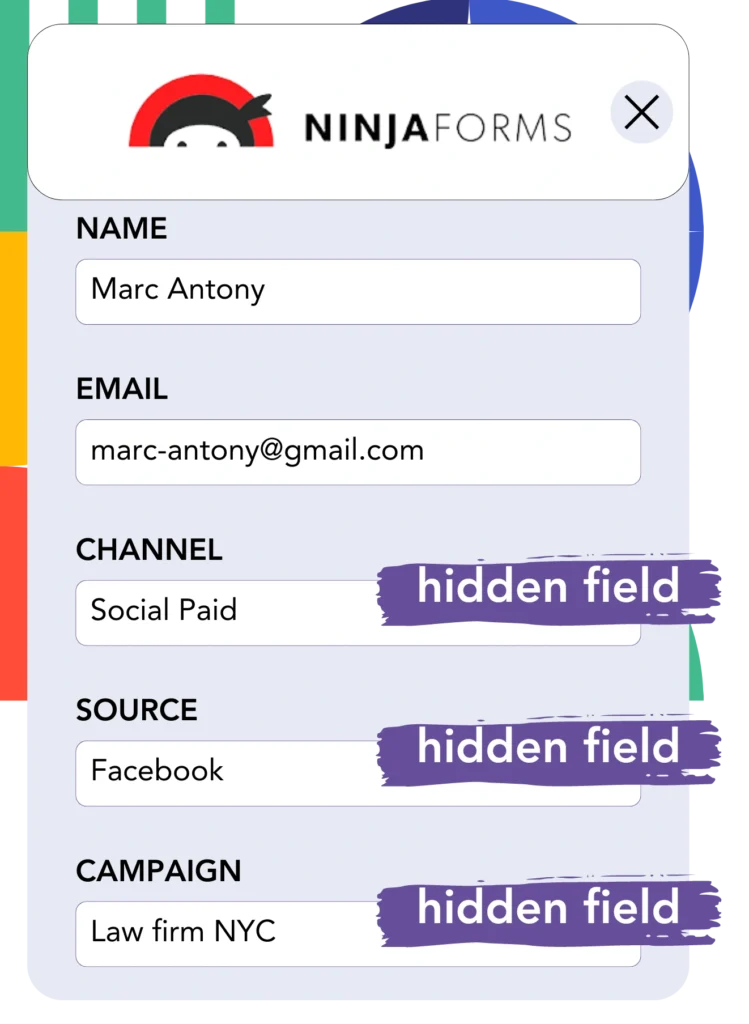Do you have difficulty identifying the Facebook ads that are driving your leads, sales, and revenue?
You likely have data on the total number of leads from each Facebook ad, but you might not be aware of the specific source of each one.
This can lead to inefficiencies in how you manage your advertising budget and resources.
Leadsources offers the answer.
Leadsources captures the effectiveness of each ad (campaign, Ad Set, audience, ad) in detail.
Ninja Forms lets you archive detailed Facebook ads data, including campaign specifics, Ad Set, audience insights, and ad details for each lead.
Generating reports, for example, “Audiences with the highest lead count,” assists in making decisions about which audiences to focus on or remove.
Let’s look into it!
Capture Facebook ads in Ninja Forms
Step 1: Add Leadsources in the head tag of your website

Sign up to Leadsources.io, and benefit from our 14-day free trial.
Add the tracking code from Leadsources to the head section of your website.
Simply follow this easy step-by-step guide.
Step 2: Add the UTM parameters to your Facebook ads campaigns

Use UTM parameters in every part of your Facebook ad campaigns (campaign, ad set, audience, ad).
You might want to include these UTM parameters in your Facebook ad links:
- UTM_source
- UTM_campaign
- UTM_term
- UTM_content
Note that even without UTM parameters, Leadsources still tracks key lead source information like channel, landing page, and landing page subfolder to provide a full understanding of your leads.
Step 3: Add the hidden fields in Ninja Forms

After the submission of your Ninja Forms, Leadsources automatically updates the hidden fields with Facebook ads data including campaign, ad set, audience, and ad.
Our guide explains how to add hidden fields in Ninja Forms to ensure your setup is complete.
Your Ninja Forms is updated with Facebook ads data by Leadsources (see Step 4 for details).
Step 4: Capture the Facebook ads data in Ninja Forms

Leadsources captures detailed Facebook ads information, including campaign, ad set, audience, and ad, when a visitor clicks and lands on your site.
Leadsources ensures that Facebook ads data is automatically inserted into the hidden fields of your Ninja Forms.
After you submit the form, both the Facebook ads data and the form responses are sent to the Ninja Forms submissions page for each lead.
How does Leadsources work?
Placing the Leadsources tracking code in the head tag of your site enables it to capture Facebook ads data, such as campaign, ad set, audience, and ad, with each visit to your website.
After collection, Facebook ads data is stored in the hidden fields of your Ninja Forms.
The following types of visitor data will be collected by Leadsources:
- Channel
- Source
- Campaign
- Content
- Term
- Landing page
- Landing page subfolder
Even if UTM parameters are absent, you can keep track of key lead source details, for example, when your traffic comes from organic sources like:
- Google Search
- Instagram bio link
- Social media posts
- Etc.
Unlike most tools that need UTM parameters to capture lead data, Leadsources works efficiently even without them.
As a result, Leadsources offers lead tracking from all channels, in contrary to many other tools:
- Organic Search
- Paid Search
- Organic Social
- Paid Social
- Referral
- Affiliate
- Display Advertising
- Direct Traffic
It allows you to unify and track all lead source data in a central location.
Pro tip:
Track Facebook Ads data in all the popular online form builders, including Cognito Forms, Gravity Forms, Jotform, Typeform, WPForms, and more. For all other form builders, refer to our guide on How to track Facebook Ads data in your online form.
How to run performance reports
Now that Ninja Forms stores your Facebook ads data, you can generate performance reports such as:
- Leads per campaign
- Leads per Ad set
- Leads per audience
- Leads per ad
- Etc.
It assists you in refining your approach to your Facebook ads budget.
We will examine the various reports you can set up.
Lead performance reports
Use reports to show how many leads were produced by:
- Channel
- Campaign
- Ad set
- Audience
- Ad
- Landing page
- Landing page subfolder
Example #1
Exporting data from different channels like SEO, PPC, and email allows you to create a report titled “Leads by Channel.”

Example #2
By determining the top-performing channel, like Facebook ads, you can concentrate on it to view leads from each specific campaign.

Example #3
When you identify the campaign with the best lead generation, you can check which audience, ad set, or ad is responsible for these leads.

Sales performance report
Finding the most effective ads and audiences for lead generation is helpful, but do they also drive revenue up?
You can create sales reports by importing data from Ninja Forms into a CRM like GoHighLevel.
Example:
| Channels | Search Paid | Social Paid |
| Leads | 50 | 75 |
| Sales | 5 | 6 |
| Average order value | $150 | $100 |
| Revenue | $750 | $600 |
Your examination of advertising results on Google and Facebook showed that Social Paid ads led to more leads than Search Paid ads.
The analysis revealed that the Search Paid channel was more efficient in generating revenue with fewer leads compared to Social Paid.
LeadSources tracks the source of each lead in Ninja Forms, whether they come from ads, organic search, social, email, etc. and syncs that data with each submission. See the full breakdown on the lead source in Ninja Forms page.

